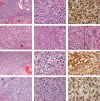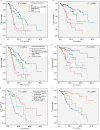Prognostic Relevance of Histomolecular Classification of Diffuse Adult High-Grade Gliomas with Necrosis
- PMID: 25407774
- PMCID: PMC8029113
- DOI: 10.1111/bpa.12227
Prognostic Relevance of Histomolecular Classification of Diffuse Adult High-Grade Gliomas with Necrosis
Abstract
Diffuse adult high-grade gliomas (HGGs) with necrosis encompass anaplastic oligodendrogliomas (AOs) with necrosis (grade III), glioblastomas (GBM, grade IV) and glioblastomas with an oligodendroglial component (GBMO, grade IV). Here, we aimed to search for prognostic relevance of histological classification and molecular alterations of these tumors. About 210 patients were included (63 AO, 56 GBM and 91 GBMO). GBMO group was split into "anaplastic oligoastrocytoma (AOA) with necrosis grade IV/GBMO," restricted to tumors showing intermingled astrocytic and oligodendroglial component, and "GBM/GBMO" based on tumors presenting oligodendroglial foci and features of GBM. Genomic arrays, IDH1 R132H expression analyses and IDH direct sequencing were performed. 1p/19q co-deletion characterized AO, whereas no IDH1 R132H expression and intact 1p/19q characterized both GBM and GBM/GBMO. AOA with necrosis/GBMO mainly demonstrated IDH1 R132H expression and intact 1p/19q. Other IDH1 or IDH2 mutations were extremely rare. Both histological and molecular classifications were predictive of progression free survival (PFS) and overall survival (OS) (P < 10(-4) ). Diffuse adult HGGs with necrosis can be split into three histomolecular groups of prognostic relevance: 1p/19q co-deleted AO, IDH1 R132H-GBM and 1p/19q intact IDH1 R132H+ gliomas that might be classified as IDH1 R132H+ GBM. Because of histomolecular heterogeneity, we suggest to remove the name GBMO.
Keywords: 1p/19q co-deletion; GBMO; IDH1 R132H immunoexpression; adult high-grade gliomas; necrosis.
© 2014 International Society of Neuropathology.
Conflict of interest statement
The authors declare no conflict of interest.
Figures



References
-
- Dehais C, Laigle‐Donadey F, Marie Y, Kujas M, Lejeune J, Benouaich‐Amiel A et al (2006) Prognostic stratification of patients with anaplastic gliomas according to genetic profile. Cancer 107:1891–1897. - PubMed
-
- Elmahdi A, Frary AJ, Scotton WJ, O'Donovan DG, Price SJ (2013) Glioblastomas with oligodendroglial component have the same clinical phenotype as classical glioblastomas. Br J Neurosurg 27:419–424. - PubMed
Publication types
MeSH terms
Substances
Supplementary concepts
LinkOut - more resources
Full Text Sources
Other Literature Sources
Medical
Molecular Biology Databases
Research Materials
Miscellaneous

